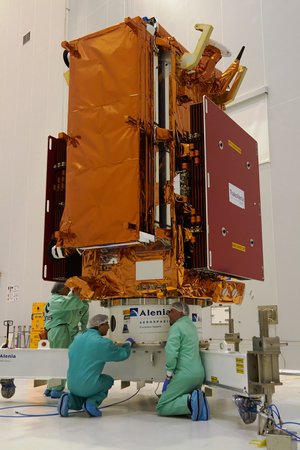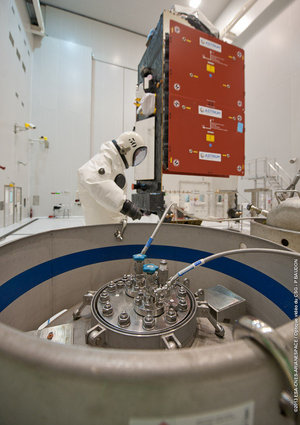

Propellant loading completed for MTG-S1 and Sentinel-4
On 17 June, the hazardous propellant loading activities began for the Meteosat Third Generation Sounder (MTG-S1) satellite, together with the instrument for the Copernicus Sentinel-4 mission, marking a significant milestone towards being ready for launch.
The propellant loading activities occur after the completion of the Standalone Phase, where satellite-only activities are conducted, but before the Joint Operations Phase in which the satellite is integrated on the launch vehicle interface adaptor(s) and encapsulated within the rocket fairing ready for lift-off once the rocket is in position. The vast majority of the critical operations carried out during the Propellant Loading Phase, and also in the Joint Operation Phase, are hazardous and therefore the highest safety measures are implemented.
Before loading the satellite with propellant, the Fuelling Readiness Review gives authorisation to proceed and confirms that all the correct checks and preparations have been carried out, including propulsion checks, inspection of the Hazardous Preparation Facility, and confirmation from ground segment control centres and status of the launcher itself.
According to James Champion, ESA’s MTG Project Manager, “everything must be synchronised to come together at the right time.”
He adds, “Propellant loading is a critical operation which must be handled exclusively by only a few experts to reduce the number of personnel involved in this extremely hazardous activity to the absolute minimum. The propellant is extremely toxic and has the significant risk of spontaneous ignition or corrosion under the right conditions if released inadvertently in the air.”
The MTG-S1 satellite was first loaded with MON3, which is used as the oxidiser in bipropellant propulsion systems: a red fuming liquid that is a mixture of nitrogen tetroxide and nitric oxide. The satellite is also loaded with Monomethylhydrazine (MMH) fuel, which is a highly toxic, volatile and flammable liquid. When the two are mixed in the right conditions within the combustion chambers of the thrusters and main engine, the two liquids spontaneously combust. This provides the force used by the satellite to perform the orbit raising manoeuvres after separation from the rocket, as well as to orientate and position the satellite correctly in its orbital slot throughout the satellite’s lifetime. Due to necessary safety precautions and the complexity of the filling operations, the MMH was loaded into the MTG-S1 satellite two days after the MON3.
Two experts, wearing the protective Self-Contained Apparatus Protective Ensemble (SCAPE) suits, are tasked with entering the loading hall to physically handle the barrels of propellant and perform the loading activities. Two colleagues remain in a dedicated safe control room in case of an emergency. The SCAPE suit, which looks similar to a special space suit, is used for these hazardous propellant loading operations on the ground.
Separately, the propellant loading director controls and guides each individual step of the colleagues performing the hazardous activity remotely, while monitoring their activities through a special video camera acquisition system.
All the tools and equipment used in such operations have to be certified according to Atmosphere Explosives directives. This means they are designed to avoid the risk of igniting the potentially explosive atmosphere. Electronic devices such as cameras or digital displays can pose a serious risk during such activities and are not permitted in the vicinity.
MTG-S1 will carry two tonnes of liquid bipropellant chemicals within its propulsion subsystem. James explains, “It embarks two types of liquid (an oxidiser and a fuel) that, when mixed in the combustion chambers of the main engine and thrusters, spontaneously combust, and are ejected out of the nozzles to provide the force to move the satellite in space so it can travel to its final geostationary orbit – 36 000 km from Earth – and allow for more than 10 years of operational orbit maintenance.”
The completion of the MTG-S1 propellant loading activities this week is another outstanding achievement. “It is very pleasing to see this significant milestone accomplished and I congratulate all teams involved,” says Christoph Goetz, ESA’s Launch Campaign Manager for MTG-S. “This marks a significant step towards the completion of our launch campaign and demonstrates the excellent teamwork performed by all stakeholders. A big thank you to everyone for ensuring that this important milestone has been maintained on schedule!”
Propellant loading was completed on Thursday, 19 June, which also coincided with a public campaign in the UK for clean air. This is very much in line with the objectives of this satellite launch, as Copernicus Sentinel-4 will be the first mission to monitor European air quality from geostationary orbit.
Read full story: MTG-S1 satellite hosting the Sentinel-4 instrument is ready for liftoff





